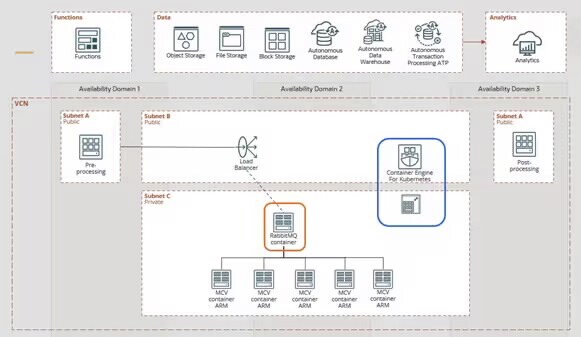Oracle Red Bull Racing increases simulations and sharpens decision-making on the track with Oracle Cloud Infrastructure
May 25, 2022 | 7 minute read
“OCI enabled us to make race-day decisions that helped Max Verstappen win the 2021 Drivers’ Championship.”

Founded in 2004, Oracle Red Bull Racing is a Formula 1 team based in the United Kingdom with over 650 races, 194 podium finishes, 4 Constructors’ Championships, and 5 Drivers’ World Championships. Formula 1 teams have almost no margin for error, with speeds exceeding 250 mph and races often decided by milliseconds.
The 2021 race season will be remembered as one of the most epic seasons of all time. It had speed, drama, controversy, and everything you could ask for in a Hollywood blockbuster. In the end, it came down to race strategy and who had the freshest tires for an incredible last lap. Oracle Red Bull Racing had their most successful season in recent history, with the team achieving 23 podium finishes and Max Verstappen winning the Drivers’ Championship. Building on the success of last year’s performance with Oracle Cloud Infrastructure (OCI), the team’s 2022 season will feature expanded use of OCI.
Oracle Red Bull Racing goals
When predicting an optimal race strategy, the Oracle Red Bull Racing engineers must overcome high levels of uncertainty. They need to calculate the impact of weather conditions, other teams’ strategies, pit stop times, and determine how a potential crash could impact the outcome of a race. To understand the consequences of these probabilities, race engineers use Monte Carlo methods to simulate billions of potential scenarios and outcomes. Although there’s no right answer, some strategies provide better odds of winning than others. As the race develops, uncertain events become reality and teams must use new data to adjust, refine, and improve their decision-making. The faster the data is processed, the faster the drivers can react with real numbers instead of relying solely on intuition. For the 2021 season, the team focused on tackling uncertainty during a race by using race simulations to predict nearly all possible outcomes.

Monte Carlo simulations on OCI
Monte Carlo simulation is a statistical analysis methodology used across many industries. Fundamentally, the simulation tells you two things: a massive set of possible outcomes that could occur, and the probability of each outcome occurring. The basis of the simulation is assigning many values to an uncertain variable to get multiple results and averaging the results to get an estimate. Monte Carlo simulations produce a distribution of the probability of outcomes occurring in an unpredictable process due to the intervention of random variables. For a Formula 1 race, the random variables include crashes and car performance.

By running Monte Carlo simulations on OCI during last season’s championship run, Oracle Red Bull Racing increased the number of simulations that they ran by 25% to improve the accuracy of their predictions and sharpen their decision-making. Further, OCI significantly reduced the cost of these simulations, enabling the team to cost-effectively improve performance on the track.
Monte Carlo simulation is basically a way of using randomness to solve a problem. We can come up with plots showing us our expected point score based on certain strategies. And you get some nice curves, and you can see where the peak of those points is. And that helps us decide how many stops we're going to make, and which tires we're going to fit, and what laps we might want to think about pitting on...
OCI will allow us to run more simulations, look at more things, and have an edge on our competitors.
Race simulation use case
During 2021, Oracle Red Bull Racing migrated their strategy systems from their preexisting infrastructure solution onto OCI. The team had previously been challenged by the limited number of simulations they were able to run during the race.
With the OCI implementation, the team ran 25% more simulations during a race. Because of this improvement in throughput, the strategy team developed the most competitive race strategy plan possible before the start of each race and made the most advantageous calls during each race. The team also shifted the preexisting on-premises infrastructure to other workloads, which they did not previously have capacity to support.
OCI enabled the team to run over a billion race strategy simulations, ensuring that they could best react to the changes happening on the track, the performance of the cars, and the actions of their competitors during the races. OCI lowered the latency and increased the volume and speed of the in-race simulations, giving the team better opportunities to react to live race events and increase their chances of winning.
In addition to the increasing the number of simulations which could be run, the cost of the simulations was reduced. OCI increased the quantity and speed of simulations, enabling the race strategists to increase the number of data inputs and run many more simulations to better predict the optimal race strategy decisions.
The cost-effectiveness and flexibility of OCI further enabled the team to scale out their simulation footprint for the future and model the strategies and reactions of their competitors.

Products used
Oracle Red Bull Racing uses the following OCI products and services to get their results:
- OCI Kubernetes Engine (OKE): An Oracle-managed container orchestration service that can reduce the time and cost to build modern cloud native applications.
- Arm cores: Processors that can be found in mobile phones, IoT sensors, and other devices and have now evolved to support hyperscale data centers and cloud computing.
- High-performance computing (HPC): A platform that includes virtual and bare metal machines at hyperscale, high-performance storage solutions and filesystems, network traffic isolation, and the tools needed to automate and run jobs seamlessly in the cloud.
Technical implementation
By using Kubernetes with OCI, Oracle Red Bull Racing developed, and deployed solutions faster, easily experimented with dozens of hardware configurations, and doubled throughput for a penny per core. OCI also enabled the team to easily deploy their setup to different locations, and scale and test on OCI. As a result, the team ran more simulations with less hardware resources, freeing up hardware to be used more efficiently.

Architecture explanation
Data storage: Data has many forms and use cases. Depending on parameters such as access time, access frequency, size, and destination, you can choose the right data storage in OCI, whether it’s on a file system, as an object, or in an autonomous database or data warehouse.
Data processing: After data hits OCI, it can be analyzed on the spot by using analytics, but often it will need to be processed. Functions can run in a tenancy to automatically run jobs on it.
Compute: Using cloud native architecture and open source technology like RabbitMQ on OKE, you can submit jobs to any numbers of workers. From 10s to 1000s, autoscaling handles the right number of workers for you.
Latest generation Ampere Arm flexible VMs don’t compromise performance for low cost. Flexible VMs let you adjust the CPU/memory ratio to make it as cost-effective as possible.
Results: Results are pushed back to the storage option of choice to be postprocessed in the cloud.
Results
Since implementing OCI, the Oracle Red Bull Racing team increased the number of simulations they ran, improved the accuracy of their predictions, and sharpened their decision-making. By containerizing their simulation application and running it on OCI’s Arm-based virtual servers, the team accelerated simulation processing speeds. This helped the team prepare their race strategies and make real-time decisions during the competition, including the optimal time to make a pit stop to change tires.
“Discovering and reacting to opportunities quickly, is crucial to our success on and off the track, and Oracle is integral in that effort. Every element of our performance is driven by data analysis. Having Oracle as our title partner shows the confidence we have in their expertise and their ability to deliver a true competitive advantage.”
–Christian Horner, Team principal and CEO, Oracle Red Bull Racing
Next steps
The team’s 2022 season will further expand the use of OCI across its most significant areas of operation including analytics-based race strategy and expanding personalized fan engagement with the Oracle Red Bull Racing Paddock. Outside of the Formula 1 team, OCI is playing an important role in developing a new generation of engine with Red Bull Advanced Powertrains, as well as helping to develop the next generation of young drivers using AI and Machine Learning in partnership with Red Bull Advanced Technologies.
Learn more about the ongoing partnership of Red Bull Racing with Oracle:
Related stories and resources
Oracle Red Bull Racing achieves record-breaking F1 season with Oracle Cloud
On the way to a new Formula One record for most wins in a season, the team uses Oracle Cloud for race simulations, fan engagement, engine development, and more.
